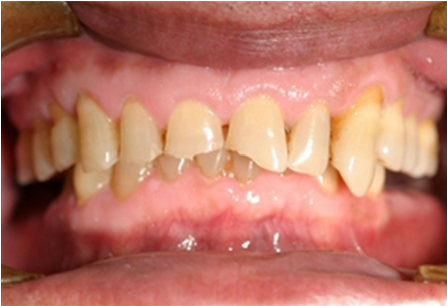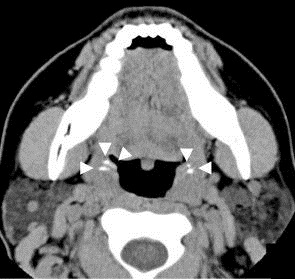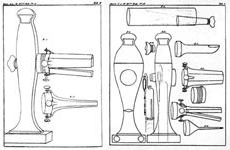|
Halitosis
Bad breath, also known as halitosis, is a symptom in which a noticeably unpleasant breath odour is present. It can result in anxiety among those affected. It is also associated with depression and symptoms of obsessive compulsive disorder. The concerns of bad breath may be divided into genuine and non-genuine cases. Of those who have genuine bad breath, about 85% of cases come from inside the mouth. The remaining cases are believed to be due to disorders in the nose, sinuses, throat, lungs, esophagus, or stomach. Rarely, bad breath can be due to an underlying medical condition such as liver failure or ketoacidosis. Non-genuine cases occur when someone complains of having bad breath but other people cannot detect it. This is estimated to make up between 5% and 72% of cases. The treatment depends on the underlying cause. Initial efforts may include tongue cleaning, mouthwash, and flossing. Tentative evidence supports the use of mouthwash containing chlorhexidine or cetylpyridi ... [...More Info...] [...Related Items...] OR: [Wikipedia] [Google] [Baidu] |
Mouthwash
Mouthwash, mouth rinse, oral rinse, or mouth bath is a liquid which is held in the mouth passively or swirled around the mouth by contraction of the perioral muscles and/or movement of the head, and may be gargled, where the head is tilted back and the liquid bubbled at the back of the mouth. Usually mouthwashes are antiseptic solutions intended to reduce the microbial load in the mouth, although other mouthwashes might be given for other reasons such as for their analgesic, anti-inflammatory or anti-fungal action. Additionally, some rinses act as saliva substitutes to neutralize acid and keep the mouth moist in xerostomia (dry mouth). Cosmetic mouthrinses temporarily control or reduce bad breath and leave the mouth with a pleasant taste. Rinsing with water or mouthwash after brushing with a fluoride toothpaste can reduce the availability of salivary fluoride. This can lower the anti-cavity re-mineralization and antibacterial effects of fluoride. Fluoridated mouthwash may mi ... [...More Info...] [...Related Items...] OR: [Wikipedia] [Google] [Baidu] |
Tongue Cleaning
A tongue cleaner (also called a tongue scraper or tongue brush) is an oral hygiene device designed to clean the Tongue disease#Idiopathic, coating on the Tongue#Surface of the tongue, upper surface of the tongue. While there is tentative benefit from the use of a tongue cleaner it is insufficient to draw clear conclusions regarding bad breath. The large surface area and Lingual papillae, lingual papilla are anatomical features of the tongue that promote tongue coating by retaining microorganisms and oral debris consisting of food, saliva and dead Epithelium, epithelial cells. Tongue cleaning is done less often than tooth brushing, Dental floss, flossing, and using mouthwash. Health effects Breath While there is tentative benefit from the use of a tongue cleaner it is insufficient to draw clear conclusions with respect to bad breath. Some studies have shown that it is the bacteria on the tongue which often produce malodorous compounds and fatty acids that may account for 80� ... [...More Info...] [...Related Items...] OR: [Wikipedia] [Google] [Baidu] |
Cetylpyridinium Chloride
Cetylpyridinium chloride (CPC) is a cationic quaternary ammonium compound used in some types of mouthwashes, toothpastes, lozenges, throat sprays, breath sprays, and nasal sprays. It is an antiseptic that kills bacteria and other microorganisms. It has been shown to be effective in preventing dental plaque and reducing gingivitis. It has also been used as an ingredient in certain pesticides. Though one study seems to indicate cetylpyridinium chloride does not cause brown tooth stains, at least one mouthwash containing CPC as an active ingredient bears the warning label "In some cases, antimicrobial rinses may cause surface staining to teeth," following a failed class-action lawsuit brought by customers whose teeth were stained. The name breaks down as: # cetyl- refers to the cetyl group, named for its relation to cetyl alcohol, which was first isolated from whale oil (); # pyridinium refers to the cation 5H5NHsup>+, the conjugate acid of pyridine; # chloride refe ... [...More Info...] [...Related Items...] OR: [Wikipedia] [Google] [Baidu] |
Flossing
Dental floss is a cord of thin filaments, typically made of nylon or silk, used in interdental cleaning to remove food and dental plaque from between teeth or places a toothbrush has difficulty reaching or is unable to reach. Its regular use as part of oral cleaning is intended to maintain oral health. Use of floss is recommended to prevent gingivitis and the build-up of plaque. The American Dental Association claims that up to 80% of plaque can be removed by flossing, and it may confer a particular benefit in individuals with orthodontic devices. However, empirical scientific evidence demonstrating the clinical benefit of flossing as an adjunct to routine tooth brushing alone remains limited. History Levi Spear Parmly (1790-1859), a dentist from New Orleans, is credited with inventing the first form of dental floss. In 1819, he recommended running a waxen silk thread "through the interstices of the teeth, between their necks and the arches of the gum, to dislodge that irr ... [...More Info...] [...Related Items...] OR: [Wikipedia] [Google] [Baidu] |
Gastroesophageal Reflux Disease
Gastroesophageal reflux disease (GERD) or gastro-oesophageal reflux disease (GORD) is a chronic upper gastrointestinal disease in which stomach content persistently and regularly flows up into the esophagus, resulting in symptoms and/or complications. Symptoms include dental corrosion, dysphagia, heartburn, odynophagia, regurgitation, non-cardiac chest pain, extraesophageal symptoms such as chronic cough, hoarseness, reflux-induced laryngitis, or asthma. In the long term, and when not treated, complications such as esophagitis, esophageal stricture, and Barrett's esophagus may arise. Risk factors include obesity, pregnancy, smoking, hiatal hernia, and taking certain medications. Medications that may cause or worsen the disease include benzodiazepines, calcium channel blockers, tricyclic antidepressants, NSAIDs, and certain asthma medicines. Acid reflux is due to poor closure of the lower esophageal sphincter, which is at the junction between the stomach and ... [...More Info...] [...Related Items...] OR: [Wikipedia] [Google] [Baidu] |
Tonsil Stones
Tonsil stones, also known as tonsilloliths, are mineralizations of debris within the crevices of the tonsils. When not mineralized, the presence of debris is known as chronic caseous tonsillitis (CCT). Symptoms may include bad breath, foreign body sensation, sore throat, pain or discomfort with swallowing, and cough. Generally there is no pain, though there may be the feeling of something present. The presence of tonsil stones may be otherwise undetectable; however, some people have reported seeing white material in the rear of their throat. Risk factors may include recurrent throat infections. Tonsil stones contain a biofilm composed of a number of different bacteria, and calcium salts, either alone or in combination with other mineral salts. While they most commonly occur in the palatine tonsils, they may also occur in the adenoids, lingual tonsils and tubal tonsil. Tonsil stones have been recorded weighing from 0.3g to 42g, and they are typically small in size. However, ... [...More Info...] [...Related Items...] OR: [Wikipedia] [Google] [Baidu] |
Tooth Decay
Tooth decay, also known as caries,The word 'caries' is a mass noun, and is not a plural of 'carie'.'' is the breakdown of teeth due to acids produced by bacteria. The resulting cavities may be a number of different colors, from yellow to black. Symptoms may include pain and difficulty eating. Complications may include periodontal disease, inflammation of the tissue around the tooth, tooth loss and infection or dental abscess, abscess formation. Tooth regeneration is an ongoing Stem-cell therapy, stem cell–based field of study that aims to find methods to reverse the effects of decay; current methods are based on easing symptoms. The cause of cavities is acid from bacteria dissolving the hard tissues of the teeth (Tooth enamel, enamel, dentin and cementum). The acid is produced by the bacteria when they break down food debris or sugar on the tooth surface. Simple sugars in food are these bacteria's primary energy source and thus a diet high in simple sugar is a risk factor. I ... [...More Info...] [...Related Items...] OR: [Wikipedia] [Google] [Baidu] |
Stomach
The stomach is a muscular, hollow organ in the upper gastrointestinal tract of Human, humans and many other animals, including several invertebrates. The Ancient Greek name for the stomach is ''gaster'' which is used as ''gastric'' in medical terms related to the stomach. The stomach has a dilated structure and functions as a vital organ in the digestive system. The stomach is involved in the gastric phase, gastric phase of digestion, following the cephalic phase in which the sight and smell of food and the act of chewing are stimuli. In the stomach a chemical breakdown of food takes place by means of secreted digestive enzymes and gastric acid. It also plays a role in regulating gut microbiota, influencing digestion and overall health. The stomach is located between the esophagus and the small intestine. The pyloric sphincter controls the passage of partially digested food (chyme) from the stomach into the duodenum, the first and shortest part of the small intestine, where p ... [...More Info...] [...Related Items...] OR: [Wikipedia] [Google] [Baidu] |
Liver Failure
Liver failure is the inability of the liver to perform its normal synthetic and metabolic functions as part of normal physiology. Two forms are recognised, acute and chronic (cirrhosis). Recently, a third form of liver failure known as acute-on-chronic liver failure (ACLF) is increasingly being recognized. Acute Acute liver failure is defined as "the rapid development of hepatocellular dysfunction, specifically coagulopathy and mental status changes (encephalopathy) in a patient without known prior liver disease".:1557 The disease process is associated with the development of a coagulopathy of liver aetiology, and clinically apparent altered level of consciousness due to hepatic encephalopathy. Several important measures are immediately necessary when the patient presents for medical attention. The diagnosis of acute liver failure is based on a physical exam, laboratory findings, patient history, and past medical history to establish mental status changes, coagulopathy, ... [...More Info...] [...Related Items...] OR: [Wikipedia] [Google] [Baidu] |
Ketoacidosis
Ketoacidosis is a metabolic state caused by uncontrolled production of ketone bodies that cause a metabolic acidosis. While ketosis refers to any elevation of blood ketones, ketoacidosis is a specific pathologic condition that results in changes in blood pH and requires medical attention. The most common cause of ketoacidosis is diabetic ketoacidosis but it can also be caused by alcohol, medications, toxins, and rarely, starvation. Signs and symptoms The symptoms of ketoacidosis are variable depending on the underlying cause. The most common symptoms include nausea, vomiting, abdominal pain, and weakness. Breath may also develop the smell of acetone as it is a volatile ketone that can be exhaled. Rapid deep breathing, or Kussmaul breathing, may be present to compensate for the metabolic acidosis. Altered mental status is more common in diabetic than alcoholic ketoacidosis. Causes Ketoacidosis is caused by the uncontrolled production of ketone bodies. Usually the production of ... [...More Info...] [...Related Items...] OR: [Wikipedia] [Google] [Baidu] |
Gastroenterology
Gastroenterology (from the Greek gastḗr- "belly", -énteron "intestine", and -logía "study of") is the branch of medicine focused on the digestive system and its disorders. The digestive system consists of the gastrointestinal tract, sometimes referred to as the ''GI tract,'' which includes the esophagus, stomach, small intestine and large intestine as well as the accessory organs of digestion which include the pancreas, gallbladder, and liver. The digestive system functions to move material through the GI tract via peristalsis, break down that material via digestion, absorb nutrients for use throughout the body, and remove waste from the body via defecation. Physicians who specialize in the medical specialty of gastroenterology are called gastroenterologists or sometimes ''GI doctors''. Some of the most common conditions managed by gastroenterologists include gastroesophageal reflux disease, gastrointestinal bleeding, irritable bowel syndrome, inflammatory bowel disease (IBD ... [...More Info...] [...Related Items...] OR: [Wikipedia] [Google] [Baidu] |
Gum Disease
Periodontal disease, also known as gum disease, is a set of inflammatory conditions affecting the tissues surrounding the teeth. In its early stage, called gingivitis, the gums become swollen and red and may bleed. It is considered the main cause of tooth loss for adults worldwide. In its more serious form, called periodontitis, the gums can pull away from the tooth, bone can be lost, and the teeth may loosen or fall out. Halitosis (bad breath) may also occur. Periodontal disease typically arises from the development of plaque biofilm, which harbors harmful bacteria such as ''Porphyromonas gingivalis'' and ''Treponema denticola''. These bacteria infect the gum tissue surrounding the teeth, leading to inflammation and, if left untreated, progressive damage to the teeth and gum tissue. Recent meta-analysis have shown that the composition of the oral microbiota and its response to periodontal disease differ between men and women. These differences are particularly notable in t ... [...More Info...] [...Related Items...] OR: [Wikipedia] [Google] [Baidu] |









